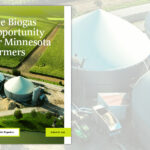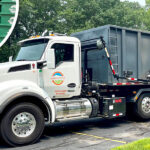Using laws of thermodynamic analysis to evaluate the energy and power characteristics of wastewater and beneficial uses of biogas offers greater insight into best business practices and what is achievable.
David Parry
BioCycle August 2014
Growing numbers of waste-water treatment plants (WWTP) are striving to produce more power onsite. In recent years, there’s even been a race among WWTP operators to see who can be “power positive” first by producing more power than their plants need to operate. Some talk of “energy neutrality” or “zero energy” and note that there is more than 10 times the amount of energy in wastewater than is required to treat it. With so much energy available from wastewater, why are so few plants power positive?
As it turns out, not all energy is the same (as will be discussed later in this article). Other considerations for comparing the energy profile of plants are the wastewater characteristics, level of treatment and the amount of resources recovered. A plant that reclaims water, dewaters and dries biosolids for beneficial use, and harvests nutrients can demand more energy than one that only treats wastewater for disposal without any resource recovery. The challenge is to produce more power than what is required to recover the resources. Recovering Biosolids, Nutrients, Energy, and Water (BNEW) can transform a WWTP into a BNEW resource center. As the efficiency of wastewater treatment is improved and more power is produced from biogas through codigestion of wastewater solids and organic waste, a power positive BNEW resource recovery center can emerge (Figure 1).
There are several drivers for power positive resource recovery (P2R2). Recovered resources can help meet demands for limited natural resources such as water (particularly in drought stricken areas), nutrients (like phosphorous, magnesium and nitrogen), and topsoil (where biosolids can improve soil conditions). Regulatory drivers include policies to divert organics from landfills or more stringent discharge requirements for receiving waters. Recovering a resource rather than wasting it can result in an economic driver. Competitive pressures or policies for sustainable practices can be a key driver as well.
Laws Of Thermodynamics
It is important to recognize that all forms of energy are not the same — the quality of the energy recovered matters. The laws of thermodynamics help illustrate the differences. If we only considered the first law of thermodynamics (conservation of energy), it appears that there is plenty of energy in wastewater for treatment. Based on typical wastewater characteristics (total suspended solids (TSS) of 250 mg/l and biological oxygen demand (BOD) of 250 mg/l) there is 200 kW per million gallons/day (MGD) of biological/chemical energy in wastewater. There is 1,000 kW/MGD of low-grade heat energy in wastewater assuming that a 12°F change in temperature could be extracted. The biological/chemical and heat energy in wastewater total about 1,200 kW/MGD of wastewater. A conventional wastewater plant demands about 83 kW of power to treat one MGD — based on 2,000 kWh/MG (WEF MOP32). Using the first law of thermodynamics, there appears to be over 14 times the amount of energy in wastewater required for treatment (1200/83 = 14).
The second law of thermodynamics states that different energy forms have different qualities. For example, electricity is a higher quality of energy than heat. Essentially all electricity can be converted into heat, but only a fraction of heat can be converted into power or electricity. In making decisions about energy systems, the quality of energy recovered must be considered.
Furthermore, energy varies in quality as both a source and a product. Sources of energy in wastewater include biological, chemical, hydraulic and thermal. Energy products include electricity, biogas, steam and hot water. These products represent different forms of energy of different qualities. Electricity is an example of high quality energy and low temperature hot water is an example of low quality energy. Electricity can be converted into heat more readily than low-grade heat can be converted into electricity. An energy system that produces electricity and heat (e.g., combined heat and power) should be viewed more favorably than one that just produces heat (e.g., a boiler). Recovered energy products that displace use of gasoline and diesel fuel (e.g., compressed natural gas and biodiesel) are currently the most valuable.
If we consider the second law, and account for the quality of energy and the ability to produce power, it appears that an efficient operation is required for power positive wastewater treatment even without any resource recovery. Most of the energy in wastewater is low-grade heat that has a low energy quality and cannot produce any significant amount of power. The remaining biological/chemical energy estimated at 200 kW per MGD can be converted into power. If all of the wastewater solids containing most of the biological energy were sent to an anaerobic digester and biogas-fueled combined heat and power (CHP) system, current best practices are exceeded if 40 percent of the energy is converted into electrical power.
Based on the second law, accounting for the quality of energy, the available power from wastewater (200 x 40 percent = 80 kW/MGD) is equivalent to the power demand (83 kW/MGD). This second law analysis indicates that it’s possible to achieve power positive wastewater treatment because the power available is equivalent to the power demand. Converting as much of the energy as possible to power and choosing energy efficient treatment processes would be necessary.
Power Positive Plant Components
Choosing energy-efficient wastewater treatment and resource recovery technologies to reduce a plant’s power demand and increasing power production through energy recovery both contribute to achieving P2R2. Energy is conserved with more anaerobic treatment than aerobic. Aerobic treatment requires air and demands more power than anaerobic treatment that produces biogas that can be used to fuel power production. Having primary sedimentation before aerobic secondary treatment reduces the aeration demand and the wastewater solids can be sent to anaerobic digesters for stabilization and biogas production. Primary sedimentation can be enhanced and additional organic waste can be accepted at the plant and sent directly to the digesters for codigestion. Codigestion is an effective method to increase biogas-fueled power production and result in a plant getting closer to or achieving P2R2. The components of codigestion are shown in Figure 2.
Biogas-fueled CHP equipment with high second-law efficiencies produces more power than heat. For example, a hot-water boiler and an internal combustion engine CHP system can both have a first-law efficiency of about 80 percent, but have vastly different second law efficiencies. A boiler can convert 80 percent of the energy in biogas into thermal energy (hot water) and a CHP system can convert the biogas energy into 35 percent electrical power and 45 percent thermal energy (35 + 45 percent = 80 percent). The boiler has a low second-law efficiency of about 4 percent because of the low quality of energy of hot water and the CHP system has a much higher second-law efficiency of about 40 percent because of the high quality of energy represented by the electric power. The first-law efficiencies of the boiler and CHP systems are the same but the CHP system has a second-law efficiency 10 times greater than the boiler. Selecting CHP equipment with high electrical efficiencies and high second-law efficiencies will help a plant achieve P2R2.
Even without resource recovery it is a challenge to achieve power positive wastewater treatment. Stringent discharge requirements like low nitrogen and phosphorous discharge limits can make it more challenging. Nutrient removal and/or adding tertiary treatment for reclaimed water and pumps for distributing the water can more than double the power demand of the plant. Achieving P2R2 at a water reclamation plant with nutrient removal is a greater accomplishment than P2R2 at a wastewater treatment plant without water reclamation or nutrient removal. Implementing and increasing the amount of codigestion can help managers of BNEW resource recovery centers become P2R2. For example, a typical wastewater treatment plant with anaerobic digestion and CHP can produce about 45 percent of its power demand. If this same plant supplemented its wastewater solids fed to the digesters with organic waste, it could be power positive with about 55 percent of the feed to the digester coming from a codigestion program. With an increased power demand from water reclamation, this plant would require about 75 percent of the feed to the digester from codigestion.
Operating a power positive wastewater treatment plant is possible but not easy. Anaerobic digestion and codigestion are key components for achieving power positive operation. Achieving P2R2 (power positive resource recovery) at a BNEW (biosolids, nutrients, energy, water) resource recovery center is even more challenging than achieving power positive wastewater treatment. Using both first and second laws of thermodynamic analysis to evaluate the energy and power characteristics of wastewater and beneficial uses of biogas give greater insight for best business practices and what is achievable. Managers of wastewater treatment plants and future BNEW facilities should consider the amount of resource recovery when striving for power positive operation.
David L. Parry, Ph.D., PE is a senior vice president with CDM Smith.















